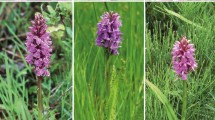Summary
Morphometry, microfluorimetry and electron microscopy were used to investigate the size, ploidy level, and morphology of the nucleus of the individual cells forming the peltate and capitate glandular trichomes inMentha×piperita L. Nuclear hypertrophy was observed in the secretory cells of both kinds of trichomes. This could be explained by polyploidization and by variations in chromatin structure which may be related to increased transcriptional activity.
Similar content being viewed by others
Abbreviations
- DAPI:
-
4′, 6-diamidino-2-phenylindole
- CV:
-
coefficients of variation
References
Amelunxen F (1964) Elektronmikroskopische Untersuchungen an den Drüsenhaaren vonMentha piperita L. Planta Med 12: 124–139
— (1965) Elektronmikroskopische Untersuchungen an den Drüsenschuppen vonMentha piperita L. Planta Med 13: 457–473
Baluska F (1990) Nuclear size, DNA content, and chromatin condensation are different in individual tissues of the maize root apex. Protoplasma 158: 45–52
Balestrini R, Berta G, Bonfante P (1992) The plant nucleus in mycorrhizal roots: positional and structural modifications. Biol Cell 75: 235–243
Bassi P (1990) Quantitative DNA variation during plant development: a critical analysis. Biol Rev 65: 185–225
Bergonioux C, Perenes C, Brown SC, Sarda C, Gadal P (1988) Relation between protoplast division, cell-cycle stage and nuclear chromatin structure. Protoplasma 142: 127–136
Berta G, Sgorbati S, Soler V, Fusconi A, Trotta A, Citterio A, Bottone MG, Sparvoli E, Scannerini S (1990) Variations in chromatin structure in host nuclei of a vesicular arbuscular mycorrhiza. New Phytol 114: 199–205
— —, Giaccone P, Gianinazzi-Pearson V (1992) Nuclear morphology and ploidy level in infected and uninfected hair root cells ofCalluna vulgaris andVaccinium myrtillus mycorrhizae. Protoplasma 170: 160–165
Cavallini A, Natali L (1991) Intraspecific variation of nuclear DNA content in plant species. Caryologia 44: 93–107
Corsi G, Corsi R (1988) Nuclear structure and DNA content in glandular hairs ofSalvia officinalis L. Hereditas 109: 83–87
—, Pagni AM (1991) The glandular hairs ofValeriana officinalis subsp.collina. II: Feulgen cytophotometric determination of the DNA content. Ann Sci Nat Bot 11: 89–94
Croteau R (1987) Biosynthesis and catabolism of monoterpenoids. Chem Rev 87: 929–954
D'Amato F (1989) Polyploidy in cell differentiation. Caryologia 42: 183–211
Deltour R, Mosen H (1987) Proposal for the macromolecular organization of higher plant nucleolonema. Biol Cell 60: 75–86
Derenzini M, Pession-Brizzi A, Betts-Eusebi C, Novello F (1981) Relationship between the fine structural organization of chromatin and nucleic acid synthesis in regenerating rat hepatocytes. J Ultrastruct Res 75: 229–242
Fahn A (1979) Secretory tissues in plants. Academic Press, New York
Gershenzon J, Maffei M, Croteau R (1989) Biochemical and histochemical localisation of monoterpene biosynthesis in the glandular trichomes of spearmint. Plant Physiol 89: 1351–1357
Guttenberger VH (1990) DNA content of the glandular hairs ofZebrina pendula. Beitr Biol Pflanzen 65: 205–210
Havelange A, Jeanny JC (1984) Changes in density of chromatin in the meristematic cells ofSinapis alba during transition to flowering. Protoplasma 122: 222–232
Jordan EG, Timmis JN, Trewavas AJ (1980) The plant nucleus. In: Tolbert NE (ed) The biochemistry of plants, vol 1, the plant cell. Academic Press, New York, pp 490–579
Koleva ST, Marinova ET, Dimitrov BD, Tourishcheva MS (1989) Investigation of histone proteins in plant nuclei possessing different ultrastuctural organization. Protoplasma 150: 96–102
Landré P (1976) Evolution of nuclear DNA content in secretory trichome cells ofSolanum nigrum L. during their formation. Caryologia 29: 235–245
Maffei M, Chialva F, Sacco T (1989) Glandular trichomes and essential oils in developing peppermint leaves. New Phytol 111: 707–716
Mazzini G, Giordano P, Riccardi A, Montecucco CM (1983) A flow cytometric study of the propidium iodide staining kinetics of human leukocytes and its relationships with chromatin structure. Cytometry 3: 443–448
McCaskill D, Gershenzon J, Croteau R (1992) Morphology and monoterpene biosynthetic capabilities of secretory cell clusters isolated from glandular trichomes of peppermint (Mentha piperita L.). Planta 187: 445–454
Nagl W (1978) Condensed interphase chromatin in plant and animal cell nuclei: fundamental differences. In: Nagl W, Hemleben V, Ehrendorfer F (eds) Chromatin: organization, evolution, function. Springer, Berlin Heidelberg New York, pp 247–260
Nagl W (1985) Chromatin organization and control of gene activity. Int Rev Cytol 94: 21–56
Nagl W, Cabirol H, Lahr C, Grenlach H, Ohliger HM (1983) Nuclear ultrastructure: morphometry of nuclei from various tissues ofCucurbita, Melandrium, Phaseolus, Tradescantia andVicia. Protoplasma 115: 59–64
Nougarède A, Rembour J (1985) Le point vegetatif en tant que modèle pour l'étude du cycle cellulaire et de ses points de contrôle. Bull Soc Bot Fr 132: 9–34
Rembour J, Nougarède A (1987) Microspectrophotometric measurements of DNA by automated computerized scanning in cycling cells of theChrysanthemum segetum shoot apex. Protoplasma 136: 183–190
Schnepf E (1974) Gland cells. In: Robards AW (ed) Dynamic aspects of plant ultrastructure. McGraw-Hill, London, pp 331–357
Sgorbati S, Levi M, Sparvoli E, Trezzi F, Lucchini G (1986) Cytometry and flow cytometry of 4′, 6-diamidino-2-phenylindole (DAPI)-stained suspensions of nuclei released from fresh and fixed tissues of plants. Physiol Plant 68: 471–476
—, Berta G, Trotta A, Schellenbaum L, Citterio A, Dela Pierre M, Gianinazzi-Pearson V, Scannerini S (1993) Chromatin structure variations in successful and unsuccessful arbuscular mycorrhizas of pea. Protoplasma 175: 1–8
Spurr AR (1969) A low viscosity epoxy resin embedding medium for electron microscopy. J Ultrastruct Res 26: 31–43
Author information
Authors and Affiliations
Rights and permissions
About this article
Cite this article
Berta, G., Dela Pierre, M. & Maffei, M. Nuclear morphology and DNA content in the glandular trichomes of peppermint (Mentha×piperita L.). Protoplasma 175, 85–92 (1993). https://doi.org/10.1007/BF01385005
Received:
Accepted:
Issue Date:
DOI: https://doi.org/10.1007/BF01385005




